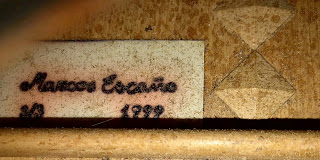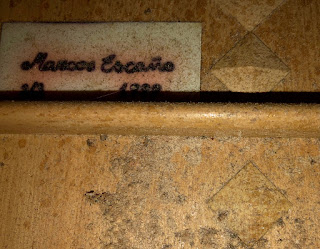
You will not meet them frequently but Andres Martin made
a lot of stringed instruments in his life. He has therefore been
mentioned in the Jose Romanillos dictionary as someone who
learned his craft with Julio Bustamante and Marcelo Barbero.
He was influenced by Santos Hernandez and Domingo
Simplicio. He taught his brother in law, Javier Rojo Solar.
His workshops were at the Rollo 3 and at Calle Divino Pastor
22 in Madrid. He died in 1977. Scale of this guitar is 660 mm.
Width of the topnut is 53 mm. Price: 950 Euro's
It must have been a lot of work to create a rosette like this...
And the same thing counts for the edge purflings.
The scratch plate could point towards a flamenco model as
does the cypres sides and back but classical Spanish music suits
this guitar as well. Profound basses and a bit of the old school
"wooden" tone. A good example of this sound can be found on
YouTube where Nikos Tsiachris plays a 1975 classical guitar
from his hand. The guitars' own frequency lies on a G#,
about 104 Herz.
Here the signed label can be admired, stating that he already
was working at the Divina Pastor 22 location in Madrid.
To our believe the year written at the lower right on this
label mentioning the year 1960. Apart from that in the
inside of this guitar a stamp can be found on the upper
bout on the left side. Near the sound hole on the right
the guitar has been signed (by 2 persons?) and dated
1960 even being numbered 275 and no doubt within
the handbuilt range we can confirm.
His graceful and immediately recognizable head, but also
showed here is the condition of the lower frets. Most of the
time an indication in what sort of condition the rest of the
fretwork is. He also used the typical Fustero tuners from
that time. Fretwork has been levelled and polished.
Probably I will French polish the neck as it doesn't feel
that comfortable at the moment. Or leave it the way it is?
No, on the right it looks (and feels) better.
Nice inlay work all around this instrument proving that
it is far from an entry level guitar. But that has already
been confirmed by the rosette itself.
And the Fustero tuners with the typical knob form
from the early sixties. The D tuner probably had a knock
as it is slightly bowed. I left that way as it still works
to full satisfaction.
The Cypress back with only one small crack that already
has been stabilized. Take a look at the lower right. Do not
expect such imperfections to have a lot of influence
on the sound.
And the front ands back of the head, reasonably free from
damages. A new topnut was necessary. On later models
the small center point that sticks out, has disappeared.
That was prone to damages of course and as for me, I
would have that disappear but I know, not original any-
more than. Moreover, Martin did this later in time so
it is a confirmation for this guitar coming out of a
certain period.
This picture has been added as I used the string
savers to get an even better angle over the bridge-
bone but they were in fact not necessary. A crack
running from the left wing of the bridge has been
repaired and is stable now. No need to worry about
that as it still was closing. No tensions there!
Another example of Andres Martins' work can
be found on YouTube: a 1975 model.
Mercian gelabelde gitaar
Ter presentatie hier een "Mercian" gelabelde gitaar waar
wel het e.e.a. over te vertellen is. Doorgaans worden alleen
studiegitaartjes van dit "merk" aangeboden en daarbij dient
vermeld te worden dat het zeer waarschijnlijk een verzonnen
merknaam is van een van de grotere muziekketens. Logisch
dat de studiegitaartjes het eerst te vinden zijn want daar
worden er de meesten van verkocht. SOLD.
Meteen al gealarmeerd door de verfijnde afwerking van
dit instrument ben ik verder gaan kijken. Geklonken
stemknoppen en een ingelegde ebben strip aan de achter-
kant van de hals die bovendien nog ter protectie van de
fretuiteinden van een palissander lining is voorzien!
Scale van deze gitaar is 650 mm en de snaarhoogte
staat nu afgesteld op 2,7 mm (hoge E- snaar) en 4 mm
voor de laagste E- snaar. Het een en ander zorgt voor
een meer dan prettige bespeelbaarheid met gewoon
nieuwe frets als een bonus natuurlijk.
Wat daarnaast bij nadere inspectie opvalt is dat de hals ook
nog eens is voorzien van een verstelbare truss rod of halspin
zoals we het vaak in Nederland aanduiden. Een rechte hals
is dan gegarandeerd al moet je wel altijd voor wat neck
relief zorgen.
Misschien niet interessant voor de klank maar wel mooi
meegenomen: Een erg smaakvolle rozet. De extra fret is
op een gracieus gevormd stukje toets toegevoegd.
Geklonken stemknoppen maar daarnaast is er ook geen
enkele beschadiging te zien op de achterkant van de kop.
Een nette brug waarin door mij een nieuw kambeentje is
gezet. Op hoogte gebracht en perfect passend gemaakt.
Hier ziet U dat de uiteinden van de frets niet te zien zijn.
's Winters willen de frets bij de temperatuurschommelingen
nog wel eens uit gaan steken. Allemaal te verhelpen maar
een binding aanleggen is wel zo'n charmante oplossing.
Een fraaie palissander achterkant en in tegenstelling tot
achterbladen met een nogal wilde tekening een gelijkmatig
lopend nerfpatroon. Wilder gefigureerde bladen kunnen
echter vaak eerder tot scheuren leiden. Massief uitgevoerd.
De "eigen frequentie" ligt op een A (110 Hz)
Strakke "Bouchet" kop, een van de meest vooraanstaande
Franse bouwers van de vorige eeuw. Ook de bebalking
wijkt nogal af van de traditionele waaier (Torres) bebalking.
Keurig geschaafd en gelijmd allemaal en het resulteert in
elk geval in een mooi geluid! De topkam is net wat
smaller dus als iemand daarvoor opteert: 50 mm.
Een shot van de mechanieken die ashouders rondom hebben
wat mij verbaast want ze zijn volgens mij toch uit de plaat
gebogen. Hoe krijg je dan het wormwieltje erdoor?
Deze foto genomen om de afwerking van de hak aan de
binnenkant te kunnen bestuderen. Keurig afgewerkt zoals
je dat meestal alleen tegenkomt bij de duurdere gitaren.
Natuurlijk nog even uw aandacht voor de mooi vormgegeven
extra uitloper van de ebben toets waarop een 19e fret geplaatst
is. Alleen al daarom natuurlijk geen beginnersgitaar...










































































